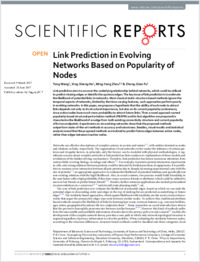Link prediction in evolving networks based on popularity of nodes
- Wang, Tong Department of Electronic Science and Technology, University of Science and Technology of China, Hefei, P. R. China
- He, Xing-Sheng Department of Electronic Science and Technology, University of Science and Technology of China, Hefei, P. R. China
- Zhou, Ming-Yang Guangdong Province Key Laboratory of Popular High Performance Computers, College of Computer Science and Software Engineering, Shenzhen University, Shenzhen, P. R. China - Physics Department, University of Fribourg, Switzerland
- Fu, Zhong-Qian Department of Electronic Science and Technology, University of Science and Technology of China, Hefei, P. R. China
-
02.08.2017
Published in:
- Scientific Reports. - 2017, vol. 7, no. 1, p. 7147
English
Link prediction aims to uncover the underlying relationship behind networks, which could be utilized to predict missing edges or identify the spurious edges. The key issue of link prediction is to estimate the likelihood of potential links in networks. Most classical static-structure based methods ignore the temporal aspects of networks, limited by the time-varying features, such approaches perform poorly in evolving networks. In this paper, we propose a hypothesis that the ability of each node to attract links depends not only on its structural importance, but also on its current popularity (activeness), since active nodes have much more probability to attract future links. Then a novel approach named popularity based structural perturbation method (PBSPM) and its fast algorithm are proposed to characterize the likelihood of an edge from both existing connectivity structure and current popularity of its two endpoints. Experiments on six evolving networks show that the proposed methods outperform state-of-the-art methods in accuracy and robustness. Besides, visual results and statistical analysis reveal that the proposed methods are inclined to predict future edges between active nodes, rather than edges between inactive nodes.
- Faculty
- Faculté des sciences et de médecine
- Department
- Département de Physique
- Language
-
- English
- Classification
- Physics
- License
-
License undefined
- Identifiers
-
- RERO DOC 305136
- DOI 10.1038/s41598-017-07315-4
- Persistent URL
- https://folia.unifr.ch/unifr/documents/305913
Statistics
Document views: 183
File downloads:
- pdf: 202
